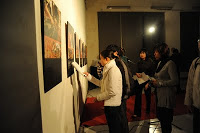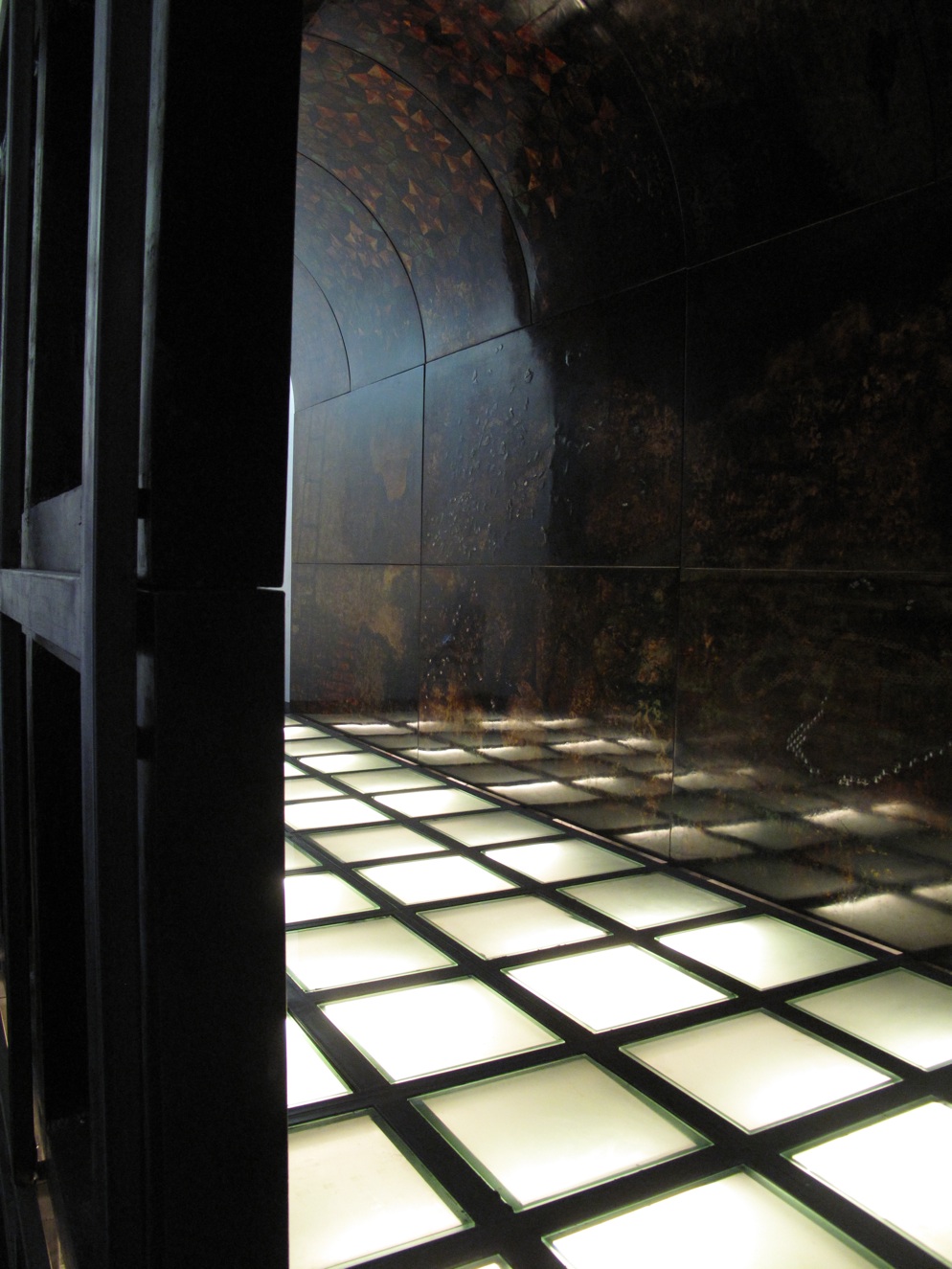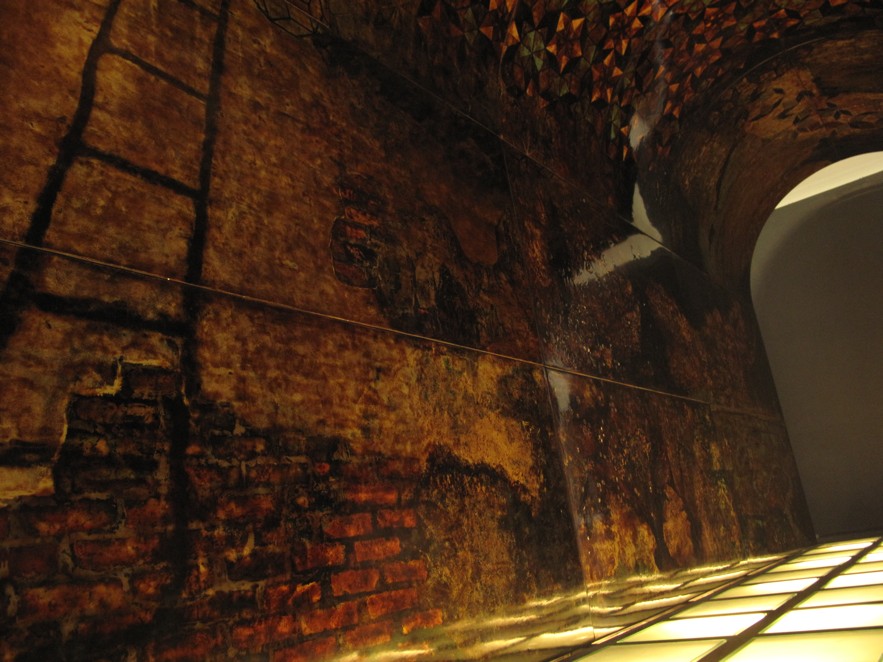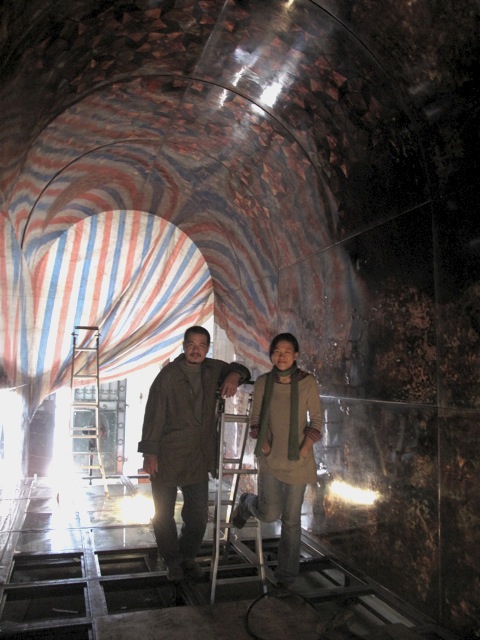29 November 2009
Hi Phi Phi thank you for your time, I know you are busy preparing two shows this December. Could you briefly talk to us about this work, how it came about and how it is specifically related to Vietnam?
Once while having my coffee in a dark, very narrow, typically nameless café in Hanoi, I was aimlessly staring at the stains of humidity, dirt, and time on the other wall when it came to my mind to create a narrow space, a tunnel, reflecting the architecture of Hanoi and enigma of its charm.
In my last work, Black Box, I started to experiment with using lacquer in a large-scale installation of composition. This time, while still using lacquer, I wanted to try to create a space that evokes time and reflection. I use lacquer's ability to embody essences and textures of hard surfaces solid matter to create the interior of a cave. Through the configuration, Specula reveals son ta's potential to relate to architecture, mural painting, sculpture, and contemporary arts.
What does the name Specula mean?
A speculum is a medical instrument used to examine internal bodily cavities. The act of entering into this tunnel-like structure to probe, examine, to see, is an implied comparison to the action of the speculum. The interior of the cave draws a parallel to the interior of self, to create a space of reflection. Incidentally, speculum is also the Latin word for mirror, another useful parallel to the surface of the imaginary cave.
Could you talk about the images in this body of work?
Specula is not a big painting or a mural in the traditional sense. I use the transparency and layering ability of lacquer to create a network of images to create an imaginary cave comprising of two halves--cave interior and cave underwater joined by an arabesque arch.
The interior half reflects some elements of prehistoric cave paintings where Paleolithic people added marks on natural rock formations to insinuate forms and volumes of bisons. When painting, I let the lacquer suggest the volumes and I added the lines accordingly. I tried to keep it simple, reduced, to allow the viewer to continue the line of the imagination, like the wonderment in looking for shapes in cloud formations or staring at the wall of the Ryo-angi gardens in Kyoto.
In the other half, the cave underwater, I play with the ebony of lacquer, the shimmer of the metals and its translucent character to give the flat cave an illusion of deep negative space and water. In different areas, I simulate the effect of looking through muddy water and finding that you can see only yourself in the reflection. On this side, I also introduce elements of Vietnamese mythology like the carp contemplating the moon, and the metamorphosis of a school of fish into a wall of bricks, or the vistas of distant mountains from the Chinese ink tradition that become the top of a pool.
The two walls bleed into an arabesque pattern taking up more than half of the curved ceiling. When I was in Spain I spent some time looking at the mosques in Andalucia. I love Islamic architecture and design. To me, Islamic design and its relationship to mathematics, order and chaos, and spirituality through harmony is very sophisticated. This is seen through its patternwork. Like everyone else , I imagine, I am fascinated by the point where art, religion, science, intersect with the question of existence. For my arabesque pattern I used the recently discovered and endlessly fascinating Penrose tile as the grid for a simple but random pattern involving stars and kites, some of the oldest symbols.
When discussing Specula, it is equally important to talk about the set design--- the physical relationship between the body and the work. These are aesthetic lessons in the tradition of modernist sculptors such as James Turrell, Anish Kapoor or Richard Serra, but also of the entrances of old Buddhist temples and even funhouse mirrors in carnival halls. Specula is a multilayered installation with many elements at play. First there is the discovery of exterior-interior, then once inside there is the claustrophobic experience of the shape of the structure on the body, then the play of moving shadows on the wall and the visual illusion of vibration and texture of the lacquer caused by the changing focus of matte and shine of the surface.
Where do you think Specula stands in relation to the tradition of lacquer?
There is much discussion about traditional lacquer painting in Vietnam, but I don't see many artists up-keeping that tradition. Considering that lacquer as a painting medium is an innovation of the 20th century, I also don't see it that old enough to have such a rigid tradition. To me, what is considered the traditional lacquer painting technique does not sufficiently account for the creative accident, expressive mark making, process orientation, inter-disciplinary practice-- elements all inherent to the medium. Instead, I see Vietnamese son ta as a contemporary art medium that is still evolving, and I'm proud to be a part in that evolution. In fact, I propose a renaissance in son ta!
In Specula and in my last exhibit Black Box, my focus is not the tradition of lacquer in Vietnam. Rather I am interested in of how the use and practice of son ta can have meaning and respond to our contemporary concerns. For example, lacquer has inherent qualities that make it particularly important today such as
-it is a natural resource that locally available
-it is a process-oriented medium that requires two essential steps for the creation of an image-- the addition of lacquer and the subtraction through sanding. This process is repeated many times throughout creating a painting paving the way for deliberate reflection.
-is the perfect marriage between environment with art because its dependency on available humidity and climate to dry is a wonderful parallel to our relationship with nature and our environment
-it can crossover to other interdisciplinary art practices, as seen here, with installation, architecture, etc
-as medium it is relatively unexplored
-It has the additional qualities of matte and shine, depth, deep but transparent blacks, transparency and translucency that other painting mediums (such as oil) do not have. This is the main reason why I think Vietnamese lacquer painting has the potential to contribute to painting history.
In a sense, son ta painting should be viewed as an entirely separate category of painting. There is nothing else like it, but up to now it has only been seen through the prism of oil painting and other painting mediums. Working in son ta, thinking about son ta, seeing son ta, I am convinced we should have an entirely different point of departure.
What is a typical day studio?
In my studio, working hours are a constant 8-6, but it is never routine and no two days are ever alike. When I started working on large compositions in lacquer, I realized that it is not a solitary individual practice but rather a team effort. I like to refer to my studio as a renaissance studio because while everyone has their role, there is a sense of an ongoing learning process, experimentation and discovery.
-Nguyen Anh Ngoc, Hanoi, November 2009































